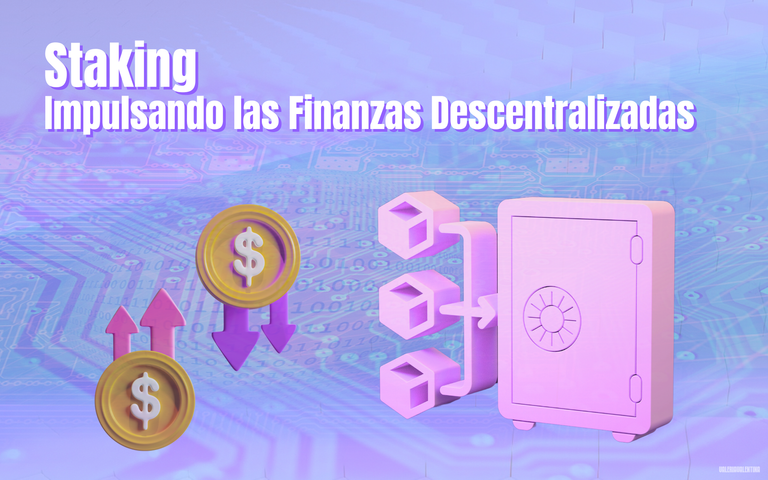
Las Finanzas Descentralizadas (DeFi) son un "canon" en el sistema financiero a nivel mundial, basadas en la tecnología Blockchain y las criptomonedas. Se trata básicamente de un ecosistema financiero abierto, transparente y sin intermediarios, que permite a los usuarios participar en una amplia gama de servicios financieros de manera autónoma y segura. Entre estos servicios financieros, está el Staking.
En el mundo de las Blockchains, la práctica de hacer "Staking" ha surgido como un mecanismo fundamental que impulsa la seguridad y la eficiencia de las redes descentralizadas. En el contexto de Web3, que representa la evolución hacia un internet descentralizado y basado en la confianza, el Staking juega un papel crucial al permitir a los participantes contribuir activamente a la validación de transacciones y la gobernanza de las redes Blockchain.
¿Sabes qué es exactamente hacer Staking?
Hacer Staking implica participar activamente en la validación de transacciones para mantener la red segura. Los participantes "bloquean" tokens para apoyar su red de preferencia y reciben recompensas a cambio. Se puede realizar a través de plataformas de Staking o con una Wallet propia. Algunas Blockchains utilizan el protocolo de consenso de prueba de participación (PoS) para el Staking, donde los validadores realizan un depósito conocido como "stake" y reciben recompensas por validar transacciones. No puedo omitir mencionar que no se pueden mover las criptomonedas durante el Staking
Beneficios del Staking
Seguridad de la Red: Al hacer Staking, los usuarios contribuyen a la seguridad y resistencia de la red al validar transacciones y mantener la integridad de la cadena de bloques.
Incentivos Económicos: El Staking ofrece a los participantes la oportunidad de obtener recompensas en forma de tokens adicionales (APR), lo que puede generar ingresos pasivos y fomentar la participación activa en la red.
Gobernanza Descentralizada: Al permitir a los participantes votar sobre cambios en la red, el Staking fomenta la gobernanza descentralizada y la toma de decisiones colectivas.
Diferentes tipos de Staking
Staking Tradicional vs. Staking en DeFi: El Staking tradicional implica bloquear criptomonedas para validar transacciones y recibir recompensas, mientras que el Staking en DeFi (Finanzas Descentralizadas) va más allá al permitir a los usuarios participar en pools de liquidez, préstamos y otras actividades financieras descentralizadas.
Staking de liquidez: Consiste en proporcionar liquidez a los mercados de criptomonedas a través de Pools de liquidez, lo que permite a los usuarios participar activamente en el ecosistema DeFi y obtener recompensas.
Staking por Participación vs. Staking por Validación: El Staking por participación implica simplemente mantener criptomonedas en una billetera para apoyar la red, mientras que el Staking por validación requiere un mayor compromiso al participar activamente en la validación de transacciones y la creación de nuevos bloques.
Staking en Cadenas de Bloques Específicas: Usualmente, cada Blockchain ofrece oportunidades de Staking únicas. Por ejemplo, Ethereum 2.0 permite a los usuarios apostar ETH para asegurar la red, Cardano ofrece un enfoque innovador en la gobernanza descentralizada, Polkadot destaca por su interoperabilidad entre Blockchains y aquí en Hive el Staking del token nativo va a nuestro HP (Hive Power) sirviendo para aumentar nuestro poder de voto, pudiendo apoyar de una mejor manera a nuestros autores favoritos para que ellos reciban recompensas más altas y nosotros también.
Staking en Interoperabilidad y Cross-Chain: Con la creciente interoperabilidad entre Blockchains, el staking cross-chain se ha vuelto popular al permitir a los usuarios participar en el Staking en múltiples redes, maximizando sus ganancias y diversificando sus inversiones.
Si nunca has hecho Staking, pero te interesa aprender a hacerlo, puedes practicar utilizando una red testnet con tokens de prueba, así no pasa nada si te equivocas. Yo recomiendo la página Filliquid con su red testnet "Calibration", vinculan su wallet de Metamask a esta red, hacen una faucet para recibir los tokens de prueba de manera gratuita y listo, podrán practicar hacer el stake de prueba en la página con el apoyo de Metamask. Quiero mencionar, por si hay dudas, que Filliquid deriva de la Blockchain Filecoin.
La práctica del Staking no es obligatoria, cada quien puede escoger si hacerlo o no, en que Blockchain hacerla o con cual token hacerlo. Existen páginas que podemos usar como Velodrome, esta utiliza la red Optimism, Metapool, que utiliza la red de Near (Aurora) y como ya mencione más arriba, tenemos a nuestro Hive, que utiliza el acumular Hive en nuestra wallet como Hive Power. Tú decides como invertir y si quieres hacerlo, aquí no damos consejos financieros, pero si te animas a practicar el Staking, ¡espero que te vaya muy bien!
ENGLISH HERE
Decentralized Finances (DeFi) are a "canon" in the financial system worldwide, based on Blockchain technology and cryptocurrencies. It is basically an open financial ecosystem, transparent and without intermediaries, which allows users to participate in a wide range of financial services autonomously and securely. Among these financial services we find the practice of doing Staking.
In the world of Blockchains, the practice of Staking has emerged as a fundamental mechanism that drives the security and efficiency of decentralized networks. In the context of Web3, which represents the evolution towards a decentralized and trust-based internet, Staking plays a crucial role by allowing participants to actively contribute to transaction validation and governance of Blockchain networks.
Do you know what exactly is Staking?
Staking involves actively participating in transaction validation to keep the network secure. Participants "block" tokens to support their network of choice and receive rewards in return. It can be done through Staking platforms or with your own Wallet. Some Blockchains use the proof-of-stake (PoS) consensus protocol for Staking, where validators make a deposit known as a "stake" and receive rewards for validating transactions. I cannot omit to mention that cryptocurrencies cannot be moved during Staking.
Benefits of Staking
Network Security: By Staking, users contribute to the security and resilience of the network by validating transactions and maintaining the integrity of the blockchain.
Economic Incentives: Staking offers participants the opportunity to earn rewards in the form of additional tokens, which can generate passive income and encourage active participation in the network.
Decentralized Governance: By allowing participants to vote on changes to the network, Staking encourages decentralized governance and collective decision making.
Different types of Staking
Traditional Staking vs. Staking in DeFi:Traditional Staking involves blockchain cryptocurrencies to validate transactions and receive rewards, while Staking in DeFi (Decentralized Finance) goes further by allowing users to participate in liquidity pools, lending and for other decentralized financial activities.
Liquidity Staking: Consists of providing liquidity to cryptocurrency markets through Liquidity Pools, allowing users to actively participate in the DeFi ecosystem and earn rewards.
Staking by Participation vs. Staking by Validation: Staking by participation involves simply holding cryptocurrencies in a wallet to support the network, while Staking by validation requires more engagement by actively participating in validating transactions and creating new blocks.
Staking on Specific Blockchains: Usually, each Blockchain offers unique Staking opportunities. For example, Ethereum 2.0 allows users to stake ETH to secure the network, Cardano offers an innovative approach to decentralized governance, Polkadot stands out for its interoperability between Blockchains and here at Hive the Staking of the native token goes to our HP (Hive Power) serving to increase our voting power, being able to better support our favorite authors so that they receive higher rewards and so do we.
Staking in Interoperability and Cross-Chain:With the increasing interoperability between Blockchains, cross-chain staking becomes relevant by allowing users to participate in Staking on multiple networks, maximizing their earnings and diversifying their investments.
If you've never done Staking, but you're interested in learning how to do it, you can practice using a testnet network with test tokens, so nothing happens if you make a mistake. I recommend the page Filliquid with its testnet "Calibration", you can link your Metamask wallet to this network, make a faucet to receive the test tokens for free and that's it, you can practice doing the test stake on the page with the support of Metamask. I want to mention, in case there are doubts, that Filliquid derives from the Blockchain Filecoin.
Practice Staking is not mandatory, everyone can choose whether to do it or not, in which Blockchain do it or with which token do it. There are sites that we can use as Velodrome, which uses the Optimism network, Metapool, which uses the Near network (Aurora) and as I mentioned above, we have our Hive, which uses the accumulation of Hive in our wallet as Hive Power. You decide how to invest and if you want to do it, I don't give financial advice here, but if you are encouraged to practice Staking, I hope it works out very well for you!

Cabecera e imágenes creadas y editadas por mí con Canva Pro
Capturas de pantalla realizadas por mí

